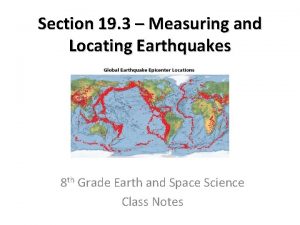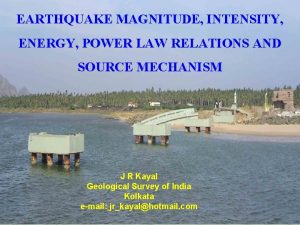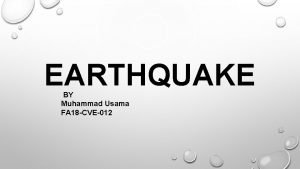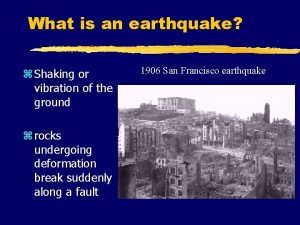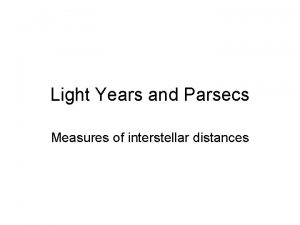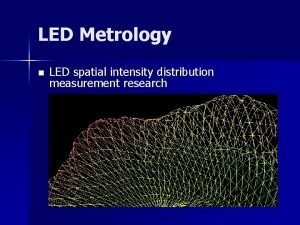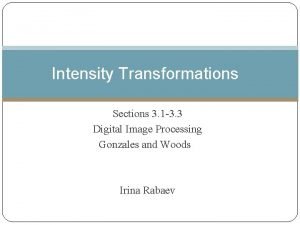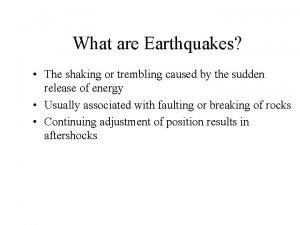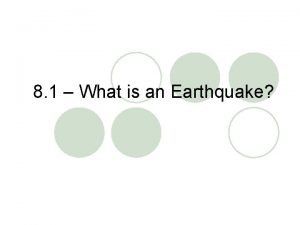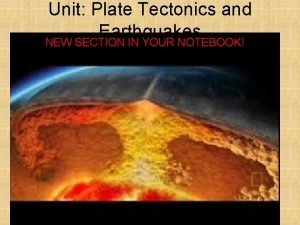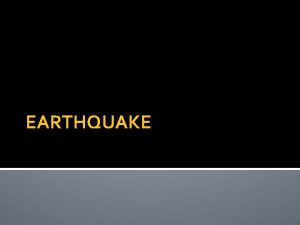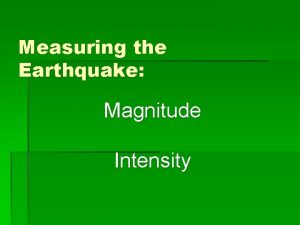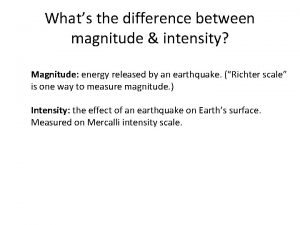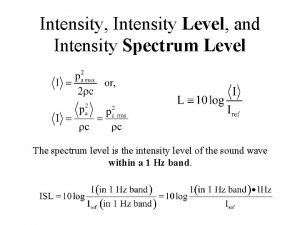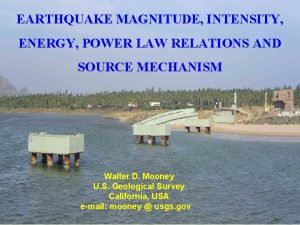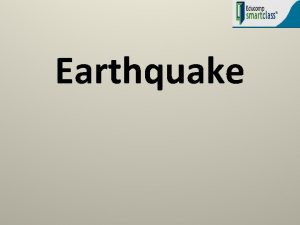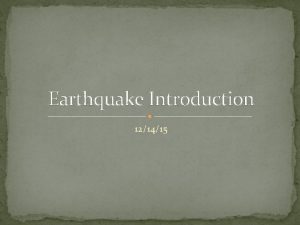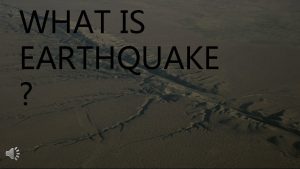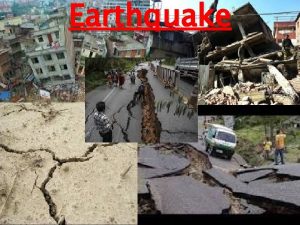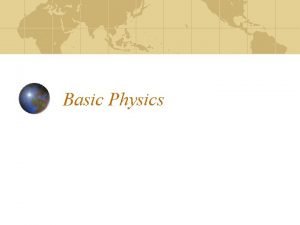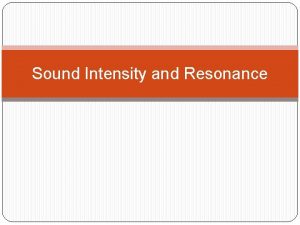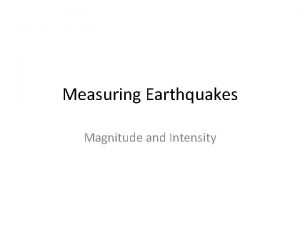EARTHQUAKE MAGNITUDE AND INTENSITY Magnitude is the measurement
















- Slides: 16

EARTHQUAKE MAGNITUDE AND INTENSITY • Magnitude is the measurement of the amount of energy released during an earthquake. • The Richter scale is a numerical scale based on the size of the largest seismic waves generated by a quake that is used to describe its magnitude. – Each successive number in the scale represents an increase in seismic-wave size, or amplitude, of a factor of 10. – Each increase in magnitude corresponds to about a 32 -fold increase in seismic energy.

HOW ARE THE SIZE AND STRENGTH OF AN EARTHQUAKE MEASURED? • Magnitude • Richter scale measures total amount of energy released by an earthquake; independent of intensity • Amplitude of the largest wave produced by an event is corrected for distance and assigned a value on an open -ended logarithmic scale


EARTHQUAKE MAGNITUDE AND INTENSITY Modified Mercalli Scale – The modified Mercalli scale, which measures the amount of damage done to the structures involved, is used to determine the intensity of an earthquake. – This scale uses the Roman numerals I to XII to designate the degree of intensity. – Specific effects or damage correspond to specific numerals; the higher the numeral, the worse the damage.

EARTHQUAKE MAGNITUDE AND INTENSITY

EARTHQUAKE MAGNITUDE AND INTENSITY Depth of Focus – Earthquake intensity is related to earthquake magnitude. – The depth of the quake’s focus is another factor that determines the intensity of an earthquake. – An earthquake can be classified as shallow, intermediate, or deep, depending on the location of the quake’s focus. – A deep-focus earthquake produces smaller vibrations at the epicenter than a shallow-focus quake.

CLASSIFICATION ACCORDING TO FOCUS DEPTHS

WHAT ARE THE DESTRUCTIVE EFFECTS OF EARTHQUAKES? Damage in Oakland, CA, 1989 • • Building collapse Fire Tsunami Ground failure

EARTHQUAKE DESTRUCTION Amplitude, duration, and damage increases in poorly consolidated rocks.

EARTH DESTRUCTION Liquefaction Unconsolidated materials saturated with water turn into a mobile fluid. Seiches - These are the rhythmic sloshing of water in lakes, reservoirs, and enclosed basins. The waves can weaken reservoir walls and cause destruction.

EARTH DESTRUCTION • Landslides and ground subsidence – Whenever the land moves quickly, as with landslides, there is the potential for a lot of damage and potential loss of life. • Fire – Ruptured gas lines from earthquakes is one of the major hazards. • Ground shaking versus material type – More ground shaking occurs in poorly consolidated (loose) sediments than solid bedrock.

EARTH DESTRUCTION Ground Rupture ‐ This refers to areas where the land splits apart causing a rupture. These are often long linear features.

TSUNAMIS – A tsunami is a large ocean wave generated by vertical motions of the seafloor during an earthquake. – These motions displace the entire column of water overlying the fault, creating bulges and depressions in the water. – Long waves that can travel at speed over 800 km/h (500 mph). – When the waves enter shallow water they may form huge breakers with heights occasionally exceeding 30 m (19 ft. ).

FORMATION OF A TSUNAMI Tsunami waves can travel at a speed of over 500 mph.

CAN EARTHQUAKES BE PREDICTED? Earthquake Precursors • changes in elevation or tilting of land surface, fluctuations in groundwater levels, magnetic field, electrical resistance of the ground • seismic dilatancy model • seismic gaps

CAN EARTHQUAKES BE PREDICTED? Earthquake Prediction Programs • include laboratory and field studies of rocks before, during, and after earthquakes • monitor activity along major faults • produce risk assessments
 Earthquake intensity depends primarily on the height of
Earthquake intensity depends primarily on the height of Earthquake magnitude classification
Earthquake magnitude classification Earthquake scale
Earthquake scale San francisco earthquake 1906 magnitude
San francisco earthquake 1906 magnitude Magnitude intensity
Magnitude intensity Chapter 8 section 1 what are earthquakes
Chapter 8 section 1 what are earthquakes Apparent magnitude equation
Apparent magnitude equation Led intensity measurement
Led intensity measurement Power law gamma transformation
Power law gamma transformation Focus and epicenter of an earthquake
Focus and epicenter of an earthquake Focus and epicenter of an earthquake
Focus and epicenter of an earthquake Earthquake p-wave and s-wave travel time graph
Earthquake p-wave and s-wave travel time graph Focus and epicenter of an earthquake
Focus and epicenter of an earthquake 1958 lituya bay earthquake and megatsunami
1958 lituya bay earthquake and megatsunami Hình ảnh bộ gõ cơ thể búng tay
Hình ảnh bộ gõ cơ thể búng tay Ng-html
Ng-html Bổ thể
Bổ thể
